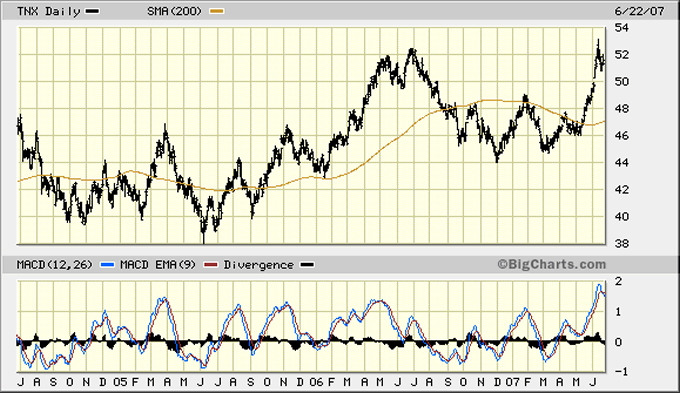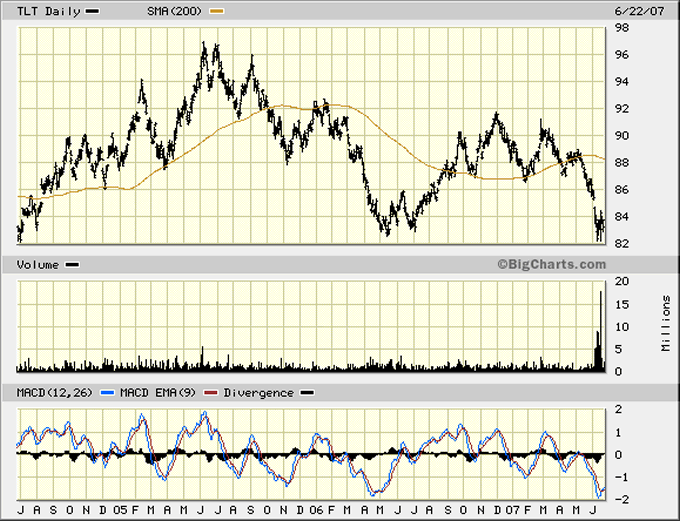Will The US Bond Market Break The Camel's Back?
Interest-Rates / US Bonds Jun 25, 2007 - 05:59 PM GMTBy: Clif_Droke
 “Bond shockwaves to ripple through U.S.” was the big, bold headline that greeted readers of the Financial Times newspaper following the recent bond sell-off and corresponding rise in yields. “A sell-off in the financial markets this week could have serious implications for the whole economy, says Krishna Guha.” Pretty dramatic stuff to say the least. But that's to be expected as the news media uses the latest financial “crisis of the week” to scare the average investor into believing financial collapse is imminent.
“Bond shockwaves to ripple through U.S.” was the big, bold headline that greeted readers of the Financial Times newspaper following the recent bond sell-off and corresponding rise in yields. “A sell-off in the financial markets this week could have serious implications for the whole economy, says Krishna Guha.” Pretty dramatic stuff to say the least. But that's to be expected as the news media uses the latest financial “crisis of the week” to scare the average investor into believing financial collapse is imminent.
The real headline of the week, however, comes from a Bloomberg report on the U.S. real estate market. The headline was predictably alarmist: “The worst is yet to come for the U.S. housing market.” Following is a sampling of what the article had to say:
“The jump in 30-year mortgage rates by more than a half a percentage point to 6.74 percent in the past five weeks is putting a crimp on borrowers with the best credit just as a crackdown in subprime lending standards limits the pool of qualified buyers. The national median home price is poised for its first annual decline since the Great Depression, and the supply of unsold homes is at a record 4.2 million, according to the National Association of Realtors.
“It's a blood bath,'' said Mark Kiesel, executive vice president of Newport Beach, California-based Pacific Investment Management Co., the manager of $668 billion in bond funds. ‘We're talking about a two- to three-year downturn that will take a whole host of characters with it, from job creation to consumer confidence. Eventually it will take the stock market and corporate profit.'
“Confidence among U.S. homebuilders fell in June to the lowest since February 1991, according to the National Association of Home Builders/Wells Fargo index released this week. Housing starts declined in May for the first time in four months, the Commerce Department reported yesterday. New-home sales will decline 33 percent from 2005's peak to the end of this year, according to the Realtors' group, exceeding the 25 percent three-year drop in 1991 that helped spark a recession.
“'It's not just a housing recession anymore, it looks more and more like an economic recession,' said Nouriel Roubini, a Clinton administration Treasury Department director and economic adviser who now runs Roubini Global Economics in New York.”
From a contrarian standpoint, the bearish psychology visible throughout the Bloomberg article couldn't be more extreme. This type of article always comes out around major lows and is to be expected. In light of this, I'm sticking by my forecast that we'll see at least a mild recovery in the housing market in the coming year. Incidentally, the Bloomberg article included the following quote from Pimco's Kiesel: “The housing sector will push the U.S. economy into recession unless the Federal Reserve cuts its benchmark rate at the first surge in unemployment.” This is another reason why I expect the Fed to cut rates this year.
Along these lines, a headline from the June 16/17 edition of the Financial Times reads: “Bernanke hints at thinking on housing.” In the article, Bernanke is quoted as acknowledging that most mortgages in the U.S. are fixed-rate and therefore most homeowners aren't nearly as exposed to interest rate gyrations as the mainstream press would have investors believe. The main thrust of the article, however, was that Bernake's Fed will focus on the housing market in making its monetary policy decisions, more so than previous Feds, and you can bet that monetary liquidity will become looser than it was during the last couple of years during Greenspan's reign of error.
While the mainstream investment press focuses on the rising bond yields and its supposedly bearish implications, little attention has been drawn to the fact that the yield curve is normalizing once again for the first time in almost a year. The slope of the yield curve has become positive once again and it's happening as the bears conveniently ignore this development. (Last year the bears made a fuss over the inverted yield curve which they said would bring down the stock market and hurl the economy into recession in 2007, which of course hasn't happened).
Mark Dodson of Hays Advisory pointed out recently that if the 90-day T-Bill falls far enough below the Fed funds rate the Fed will cut the rate. He further pointed out that with the T-bill where it is currently there is a “virtual guarantee that a Fed Funds rate hike is not in the cards….the probable Fed move is toward easing.” That has been my reading of the situation as well.
Also noteworthy is that while the 10-year Yield has spiked upward, the bond market's inflation expectations refused to move higher in non-confirmation of the yield rise. The spread between the 10-year note and the 10-year inflation-protected TIPS yield show that inflation is not the real culprit here. Once again, it appears that the bears, along with the press, are trying to focus investors' attention in the wrong direction.
With respect to the bond market tanking (and yields spiking), what will become of the 10-year Treasury Yield trend? The CBOE Treasury Yield Index (TNX) is now way over-extended from its 200-day moving average and the oscillators and MACD indicator is reflecting a super-overbought technical condition. This suggests a pullback is in order for TNX in the immediate term. Once TNX “corrects” itself internally, do the odds favor it taking off again by making higher highs above the most recent one? I say no, the odds are against a sustained upward surge in TNX. The intermediate-term momentum just isn't there and let's not forget that the super long-term trend is still down for yields. I consider the latest spike in yields to be a false alarm and not the start of longer-term uptrend.

I've been reading some high-profile commentary on the bond market and the consensus seems to be that “the bull market in bonds is over” and “the long-term downtrend in yields is broken.” Even the Financial Times got in on the act by showing a large-sized chart of the 10-year Treasury Yield index along with a downtrend line that it concluded, like many others, had been “broken.” I don't buy that. Just because yields barely nudged above the long-term downtrend line doesn't mean the downtrend is over. It takes more than just a poke above a downtrend line to formally break and reverse a major long-term trend. After all, how many times along the yield trend have we seen false upside breakouts occur within a downtrend only to be reversed and have the downtrend resume? Too numerous to count!
While we're on the subject of the bond market, I came across an astonishing analytical piece this past week that points to the same conclusion I've made on the bond market, viz., the insiders are currently loading up the proverbial wagon with bonds and have used the recent bond plunge to become heavy buyers. Dr. George Dagnino of the Peter Dag Portfolio, wrote in his blog for Thursday, June 21, that “in the past two weeks investors have entered positions totaling more than $5 trillion, close to half the U.S. economy”, in a Treasury market instrument. His comments are excerpted below:
“30 MM shares in TLT…were traded at an average price of $84. The amount of dollars traded is unbelievable -- 30 MM time $84 = $2.5 trillion! Am I right? In the past two weeks investors bought an amount of TLT equal to about half the U.S. economy? Can you believe this?”
It's hard to believe but it's clear that the big boys are big buyers of bonds right now. Just take a look at the TLT chart below. (TLT is the symbol for the iShares Lehman 20+ Year Treasury Bond ETF which closely corresponds to the bond price trend). The chart speaks for itself and makes a strong case for capitulation of the bond market decline. Notice also the extremely heavy trading volume near the recent lows.

Fed chairman Bernanke earlier this year made reference to what he called a “global savings glut.” Reading between the lines of this widely quoted remark, what the Fed is saying is that it sees a coming time, undoubtedly this year, when it will have to act to loosen up the public's savings and get the money flowing in the direction of the stock market once again. One catalyst for this loosening up of the savings purse strings will be a lowering of the Fed funds rate.
Another will be when the dust clears from the current “crisis of the week” in the form of the spiking Treasury yields (not to mention the consequent fear of an earnings slowdown and further weakness in real estate). When investors realize that these bearish scenarios have been overblown by the media, I believe we'll see a further lifting of the “veil of fear.” And that's exactly what the market needs to really get jumping again.
By Clif Droke
www.clifdroke.com
Clif Droke is editor of the daily Durban Deep/XAU Report which covers South African, U.S. and Canadian gold and silver mining equities and forecasts PM trends, short- and intermediate-term, using unique proprietary analytical methods and internal momentum analysis. He is also the author of numerous books, including "Stock Trading with Moving Averages." For more information visit www.clifdroke.com
Clif Droke Archive |
© 2005-2022 http://www.MarketOracle.co.uk - The Market Oracle is a FREE Daily Financial Markets Analysis & Forecasting online publication.


